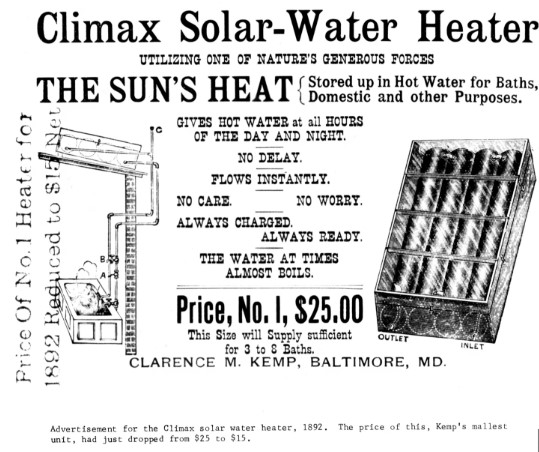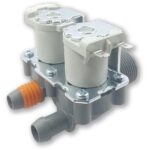The History of the Solar Water Heater
The sun, the source of life on Earth
The sun is the center of the solar system. The energy it releases heats our planet and feeds every form of life on earth. Through the process of photosynthesis, solar energy is converted into organic matter, which makes the existence of life possible.
The fossil fuels we use extensively are essentially also solar energy stored in the earth. However, they are not renewable. The energy the sun sends us is so abundant. Many might think that due to the advanced technology that humanity currently possesses, the exploitation of solar energy is something that started happening recently. But this is not true. From the time when humanity lived in caves… people chose those that faced southeast. This allowed the morning sun to warm them without overheating them during the hot months.
Perhaps you are interested:
What is solar energy and how do we use it?
The ancient Greeks
Sunshine is the main characteristic of the Greek climate. The ancient Greeks never needed sensor networks or modern meteorological stations to understand and exploit the divine gift. In a region where there is sun almost all year round (even in the northern areas of the country sunshine is abundant) what someone needs to do is to exploit the sun’s rays in winter to get warm and avoid them during summer to protect themselves from overheating.
Excavations in many ancient Greek cities and settlements have shown that individual houses and buildings were built facing south. Even entire cities were designed in a way so that all buildings had equal (fair) sunshine (access to free energy) during winter. It is interesting to observe that around 500 BC when the Greeks largely deforested their territory they had to find alternative energy sources. So then they turned to solar energy.
Native Americans
The indigenous people of America in the southwest oriented their homes in a way so that the sun would heat them while exploiting the rocks in summer to keep them away from the sun’s rays. Their environmentally friendly life is well known, something that has not changed to this day.
Roman Empire
The ancient Romans raised the level of using solar energy for providing heat significantly. Beyond the tactics already mentioned regarding the orientation of buildings and adaptation according to local climate peculiarities, they used transparent (glass) coverings in the openings (doors – windows) of their buildings. This greatly increased the efficiency of solar energy in indoor spaces while influencing architecture in many areas such as greenhouses, baths, etc. The influence of the sun on architecture was so great that the “right” to access the sun was included in Roman law. It should be noted that the Romans also deforested their territories.
Solar energy was forgotten
After the fall of the Roman Empire, the use of glass was forgotten and with it the benefits of solar radiation in heating buildings. Interest was rekindled during the Renaissance both in building architecture and in greenhouses. Evolving technology allowed glass production and this influenced architecture, the use of glass began to increase again. The first large greenhouses were created both for productive reasons (cultivation) and for people to spend their time (recreation).
Around 1700 the leading naturalist Horace de Saussure began experimenting with solar hot boxes. These were essentially the ancestors of today’s solar collectors. They were simple insulated boxes painted black with one side covered with glass. They looked very much like today’s solar ovens while many of the first experiments were done for cooking. Also the solar wax melters that beekeepers use to melt old honeycombs and “separate” the wax constitute a variation of the same construction. At that time whatever experiments were done had few successes.
The first patent for water heating with solar energy and the beginning of modern solar water heaters in America
Shortly before 1900, pipe networks began to be created for water supply to the urban environment. Just as today, so then the water that ran in the networks was quite cold. People began to look for ways to heat water. The first water heaters for providing hot water for use were fueled with wood or coal. In 1891 Clarence M. Kemp patented the world’s first solar water heater called climax. It was a black water tank inside an insulated wooden box with one side being glass. Great similarity to the first trials with solar boxes, with the difference that now the goal was to heat water!

The first product became popular in California, a region where it could be used almost all year round. It should be noted that California has a similar climate to Greek – Mediterranean. Thousands of such or similar devices were manufactured and installed in a short period of time. In this type of devices the sun directly heats the water contained inside the black tank and the water remains stored in the same place.
In 1909 an engineer from California as well, William J. Bailey began selling another product which he called “day and night” solar water heaters. It consisted of solar collectors and a separate water storage tank above the collectors. The storage tank (reservoir) was insulated for additional heat retention. The collector consisted of an arrangement of pipes fixed on a flat surface and enclosed in an insulated box with a glass cover. The system was filled with water and as it was heated by the sun it rose to the tank for use at a later time. These systems looked quite similar to today’s, not so much in terms of materials but in shape and philosophy.
In 1913 a terrible freeze hit California and many solar water heaters of this type froze and “burst”. To avoid or limit similar situations in the future, Bailey installed a coil of pipe inside the tank to act as a heat exchanger. He also used a mixture of water and alcohol as antifreeze inside the exchanger. So as this liquid was heated by the sun it rose inside the exchanger (coil). Thus without direct contact the water in the tank was heated by contact with the exchanger and the exchanger liquid made a circuit fed by the temperature difference. These are the systems we call closed circuit today. The patents and implementations described so far (1913) essentially describe to us how solar water heaters work even today, more than 100 years later.
Natural gas almost made solar energy disappear again
During the decades of the 1920s and 1930s huge quantities of natural gas were found in the Los Angeles area. Bailey himself began manufacturing water heaters that used natural gas as fuel, since it was very cheap and abundant. He also made them to be controlled by thermostats providing on-demand hot water for use day and night without effort for the user. Sales of this new product skyrocketed while solar water heater sales fell. Natural gas distribution and supply companies offered strong incentives for homes to become part of the new network. This fact dropped solar water heater sales even more and finally Bailey’s last ones came off the production line in 1941.
History changed and took its final course
But before this end came for Bailey, other entrepreneurs took the solar water heater designs to Florida. There history was written and success was unprecedented. In the urban explosion that took place between 1935 and 1941 over 60,000 systems were installed. More than half the population in Miami was using solar water heaters in 1941 while 80% of the houses built during that period had some kind of installation for exploiting solar energy.
World War II
During World War II the production and installation of solar water heaters stopped. Copper was a main raw material for manufacturing solar water heaters and during the war its use was “frozen” for any other use except the war industry. When the war ended the manufacturing companies returned but other conditions that had formed pushed solar water heaters into obscurity.
The existing solar water heaters that had been installed during the previous flourishing of the industry were now considered small for the needs that arose. Automatic washing machines for clothes, dishes and similar washing appliances had a demand for hot water such that the solar water heaters of that era could not cover. The final blow was given by the new pricing policy for electric energy which after the war was reduced by half making it much more economical and affordable for everyone.
An example of what prevailed at that time regarding the use of electric energy (produced conventionally) was the aggressive policy in Florida where free installation of an electric water heater was offered to cover the needs for hot water for use with the now cheap electric current. At the same time the old solar water heaters already had several years of operation and showed wear, material failures and leaks. Most households found it more economical to replace them with cheap electric water heaters than to repair the old solar ones. The decades of the 1950s and 1960s were for the United States years of unbridled electric energy consumption. For almost everyone (except a small minority) the use of solar energy made no sense and seemed primitive.
The oil embargo and its role in the evolution of history
In 1973 the first oil embargo by Arab countries against America was imposed. Then America experienced situations that were not familiar to it. Fuel shortages, long queues at gas stations, shortages obviously also in heating fuels while the prices of small quantities doubled and tripled. President Jimmy Carter helped America move toward energy efficiency and made the use of renewable energy sources a national priority. In a symbolic move he installed 32 solar collectors on the roof of the White House for providing hot water for use (in 1986 under the presidency of Ronald Reagan they were removed from the White House). Former President Carter did not change his stance toward renewable energy sources and proved it with his subsequent attitude.
The energy crisis and oil embargo changed the United States. With the end of the Vietnam War as well they realized some of their weaknesses and changed their perspective around energy use. Consumers began looking for appliances with better energy efficiency as well as cars. The need for independence from fossil fuels (from the Middle East) brought the entire nation to try to replace part of their energy needs with renewable energy sources. This was of course a challenge, not something simple. The need brought technological progress and companies around the renewable energy sector sprouted everywhere to cover the increasing demand. State support for research in renewable energy skyrocketed from 1 million to 400 (it should be noted that this constituted a fraction compared to the corresponding amounts concerning nuclear energy).
During the decades of the 1970s and 1980s the installation of infrastructure using solar energy was identified with patriotism. The legislation of many states included regulations to provide incentives for installing renewable energy infrastructure. For example tax reliefs. A new period of flourishing began and people started doing research and wanting to install wind turbines, photovoltaics, active and passive heating systems and naturally turned again to the old and tested solution for producing hot water for use, solar water heaters that went through several waves to be considered today an obvious solution.
During the phase of explosion in demand for devices using solar energy, implementations appeared in commerce that were inadequate with design errors but mainly without being adequately tested. The failure of some implementations gave a bad name but like all industries so too the renewable energy industry experienced some abnormalities and then stabilized regarding the quality of its products.
The fossil fuel lobby and its role
The current that was created for the widespread use of renewable energy sources did not sit well with those who profited from selling fossil fuels. After the most expensive electoral campaign in the United States, Ronald Reagan was elected president. This campaign was funded by oil companies. The intentions of the new president but mainly those who supported him and promoted his election did not take long to show. During his presidency the return of the US to fossil fuels became clear. Perhaps as a symbolic move (corresponding to that of President Carter but with opposite content), the solar collectors that declared and “set an example” for all American citizens to use renewable energy and have sensitivity regarding energy conservation were immediately removed from the White House.
Between 1981 and 1986 the way the public perceives politics in relation to energy issues changed forever. One could claim that simply US policy changed and they turned again due to circumstances to cheaper energy to support the economy. During Reagan’s administration however, funding for research programs concerning renewable energy was drastically cut.
At the moment when all other developing countries continued their effort for generalizing the use of renewable energy sources America abandoned them. European and Asian countries reduced energy consumption in relation to their GDP by about half compared to North America. Although they maintained a similar lifestyle to the American one, a 50% reduction in energy consumption was achieved. The comparison of Israel’s example is worth it in how the energy shortage was dealt with compared to America. Of course different scales in terms of population, area and economy. Israel found itself in need and took drastic measures. It treated solar energy as a stable source and not as a temporary solution that we use only when all other energy sources are found inadequate.
Reagan decimated the solar energy industry in America at the moment when other nations elevated it to the main solution for dealing with energy issues. He set a goal to abolish every tax relief related to renewable energy and limited funding for research in this sector by 90%. The stance and policies applied by his administration dealt the final blow to the American solar water heater industry. During the period 1984-1986 solar water heater sales fell by more than 91%. Until the 1990s the industry remained alive thanks to those who invested in solar energy out of conscience and not from a cost perspective. That is, from individuals who understood the meaning of energy conservation and not money conservation. From antiquity until today the majority of people, although they know the difference, ultimately choose based on money.











